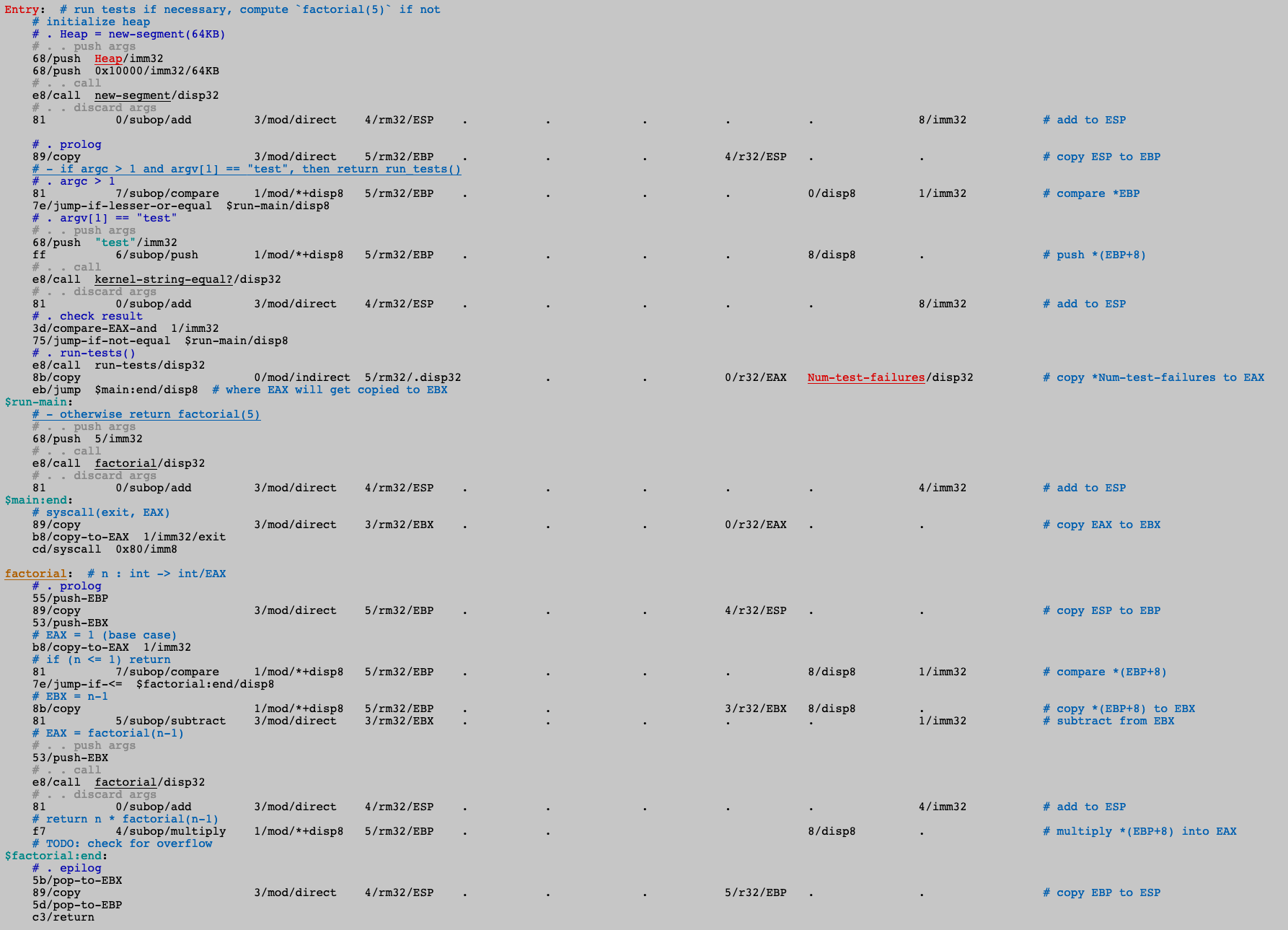Sep 2, 2019
Update on the Mu computer
Now that we have a notation for addressing modes, we're designing syntax for function calls.

It's easiest to parse if we start with a paren and avoid commas. However, the similarity to s-expressions is only skin deep. There can only be 2 levels of parens, and args can't do arbitrary arithmetic.
Pseudocode
Uses the just-created addressing mode notation!
More info: https://github.com/akkartik/mu#readme
permalink
* *
Aug 31, 2019
More deletions later, LoC in my fork of the Linux kernel are down from 27.1M to 12.3M. Goal is to only support lowest-common-denominator devices.
https://github.com/akkartik/mu#readme
(My line-counting was way off earlier.)
permalink
* *
Aug 30, 2019
Reason #83 to fork the Linux Kernel
I get to see my name and picture on a git log alongside Linus Torvalds's.
https://github.com/akkartik/kernel#readme
permalink
* *
Aug 25, 2019
Update on the Mu computer
Now that we have a bootstrapped (quasi-) language and (kinda) bootstrapped OS, we're finally starting to think about less error-prone notations.
This week two of us built a notation for x86 addressing modes:
- direct:
%ecx
- indirect:
*ecx
- indirect with displacement:
*(ecx+4)
- indirect with index, scale and displacement:
*(ecx + edx<<3 + 4)
Not yet sure this is a good approach. But it'll be fun to playtest.
Here's before and after screenshots for factorial.subx.
Before:

After:

(project link)
permalink
* *
Aug 20, 2019
Now that I have the beginnings of a whole new computer, I'm at a loss for what to work on next. (One of the items is
H's suggestion of socket syscalls.)
Today's little mini-experiment: a program to print out random numbers in an infinite loop. Works fine on Linux or Mac, but only prints zeroes when packaged up with my kernel fork and run on Qemu or Linode. Looks like I need to do something to initialize /dev/random.
(More details)
Here's my complete current list of ideas, just for triggering serendipity:
- Test /dev/random without my kernel changes
- Test framebuffer syscalls
- Client socket helpers
- A compiled language -- kinda like my previous prototype (https://github.com/akkartik/mu1#readme)
- Some sort of storage. Either ramdisk (volatile) or local disk (needs mount) or S3 (needs sockets)
- An interpreted language. Either a subset of Oil or a straight-up Lisp. Needs storage.
permalink
* *
Aug 19, 2019
Updated Mu's fork of the Linux kernel again. Today I deleted the entire top-level sound/ directory and a whole bunch of unused file systems.
LoC down from 6.1M to 4.4M.
Context: https://github.com/akkartik/mu#readme
permalink
* *
Aug 14, 2019
Stack manipulations in SubX
I've been noodling on a Forth-inspired (but likely insane) syntactic sugar
for stack manipulations in raw machine code. Behold:
{ 0 0 ->%ecx
...
}
This expands to:
push 0/imm32
push 0/imm32
copy %esp to %ecx
...
add 8 to %esp
Basically you get a (fairly unsafe) block scope containing an 8-byte local in %ecx.
To temporarily spill a register:
{ %ecx
...
}
Function call:
{ z y x
call f/disp32
}
The `}` turns into code to undo pushes in the `{` line.
permalink
* *
Aug 11, 2019
Now that I'm packaging Mu with a fork of bleeding-edge Linux, I have a tiger by the tail. I need to stay abreast of changes from upstream or risk bitrot, particularly as new security vulnerabilities are uncovered and patched.
I'm going to start changing the kernel soon, and I need a way to not kill myself merging patches from upstream. For starters: aggressively delete code Mu doesn't need. That'll reduce merge conflicts.
In the first run I just deleted non-x86 architectures. So far so good.
permalink
* *
Aug 10, 2019
Turn a set of .subx files into a bootable disk image.
$ git clone https://github.com/akkartik/mu
$ cd mu
# package up a "hello world" binary and Linux kernel into mu.iso
$ ./gen_iso examples/ex6.subx
# try it out
$ qemu-system-x86_64 -m 256M -cdrom mu.iso -boot d
https://github.com/akkartik/mu#readme
The process is still fairly klunky, and I've added several large dependencies. But now that I have something working I can start polishing it.
Credit: http://minimal.linux-bg.org/
One aspect that seems more broadly useful than just my own Assembly language project: how to deploy bootable disk images on Linode.
permalink
* *
Aug 8, 2019
Cloud VPS from "scratch"
I just successfully built a minimal Linux kernel, installed a SubX binary as init -- and ran the whole thing on a Linode.

It's not in https://github.com/akkartik/mu yet, but there will soon be step-by-step instructions.
This couldn't have happened without the education I received from http://minimal.linux-bg.org
permalink
* *



